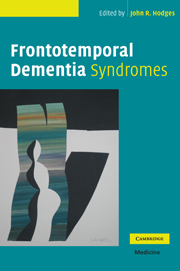Book contents
- Frontmatter
- Contents
- List of contributors page
- Preface
- 1 Overview of frontotemporal dementia
- 2 Epidemiology of frontotemporal dementia
- 3 Clinical presentations of frontotemporal dementia
- 4 Overlap syndromes
- 5 The neuropsychology of frontotemporal dementia
- 6 Neuroimaging and other investigative findings
- 7 The histopathology of frontotemporal dementia
- 8 Molecular neuropathology in familial and sporadic frontotemporal dementia
- 9 The genetics of frontotemporal dementia
- 10 Psychological interventions in frontotemporal dementia
- Index
7 - The histopathology of frontotemporal dementia
Published online by Cambridge University Press: 05 August 2016
- Frontmatter
- Contents
- List of contributors page
- Preface
- 1 Overview of frontotemporal dementia
- 2 Epidemiology of frontotemporal dementia
- 3 Clinical presentations of frontotemporal dementia
- 4 Overlap syndromes
- 5 The neuropsychology of frontotemporal dementia
- 6 Neuroimaging and other investigative findings
- 7 The histopathology of frontotemporal dementia
- 8 Molecular neuropathology in familial and sporadic frontotemporal dementia
- 9 The genetics of frontotemporal dementia
- 10 Psychological interventions in frontotemporal dementia
- Index
Summary
Introduction
The emergence of frontotemporal dementia (FTD) as a clinical entity (McKhann et al., 2001; Neary et al., 1998) has provided impetus to disciplines ranging from genetics to neuropsychology (Hodges and Miller, 2001a, 2001b). The concept of FTD,1 however, is fundamentally heterogeneous. Histopathological characteristics form the hub of this heterogeneity, relating on the one hand to the varied clinical manifestations of FTD and, on the other, to findings in the burgeoning field of FTD genetics.
The chapter begins with an historical introduction to the concept of FTD followed by an outline of the various histopathological subtypes. After briefly describing the clinical spectrum of FTD we discuss clinico-pathological insights that have been acquired as post-mortem collections, instigated more than a decade ago, have matured. We emphasise the feasibility of predicting pathological subtype during life, at least in a proportion of FTD cases. We then explore the complex relationship between the genetics and histopathology of FTD. We conclude with the unifying perspective that FTD may be understood as pathology affecting one or more neural systems.
Historical background
In 1907 Alois Alzheimer described the neuropathological findings in a woman who died at the age of 56 after a 5-year illness consisting of cognitive impairment and psychiatric disturbance; silver-staining plaques and tangles were seen on microscopic examination (Alzheimer, 1907). Although similar appearances had previously been documented in older patients, the term “Alzheimer's disease” (AD) began to be used for this combination of plaques and tangles from 1910 (Kraepelin, 1910). Alzheimer's disease, formally diagnosed at post-mortem examination, now encompasses both senile and pre-senile cases. It is so common, accounting for two-thirds of dementia cases among those aged older than 65 (perhaps half a million cases in the UK), that its particular features pervade our concepts of dementia in general (Bachman et al., 1992). For instance, the stipulation that dementia should only be diagnosed in patients above a certain age in whom memory impairment is detected derives from the typical presentation of AD with amnesia in the elderly (DSM–IV–TR; American Psychiatric Association, 2000). Indeed, about 90% of patients manifesting such features have the neuropathological characteristics listed by Alzheimer (Tierney et al., 1988).
- Type
- Chapter
- Information
- Frontotemporal Dementia Syndromes , pp. 161 - 207Publisher: Cambridge University PressPrint publication year: 2007
- 1
- Cited by



